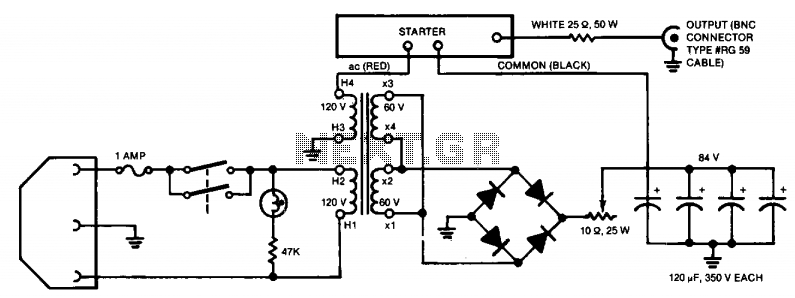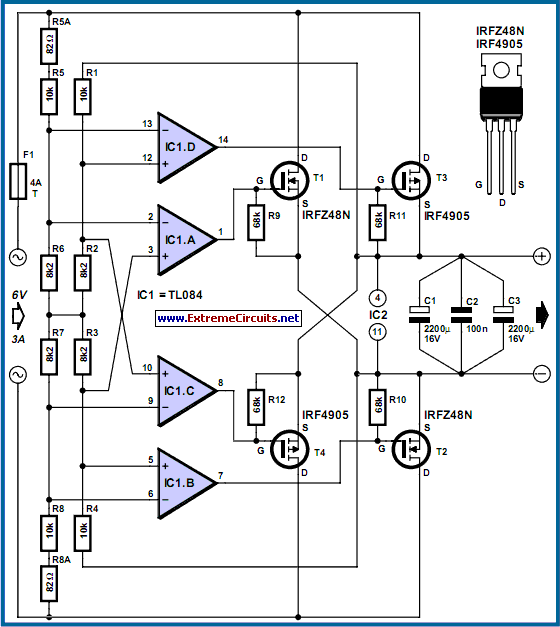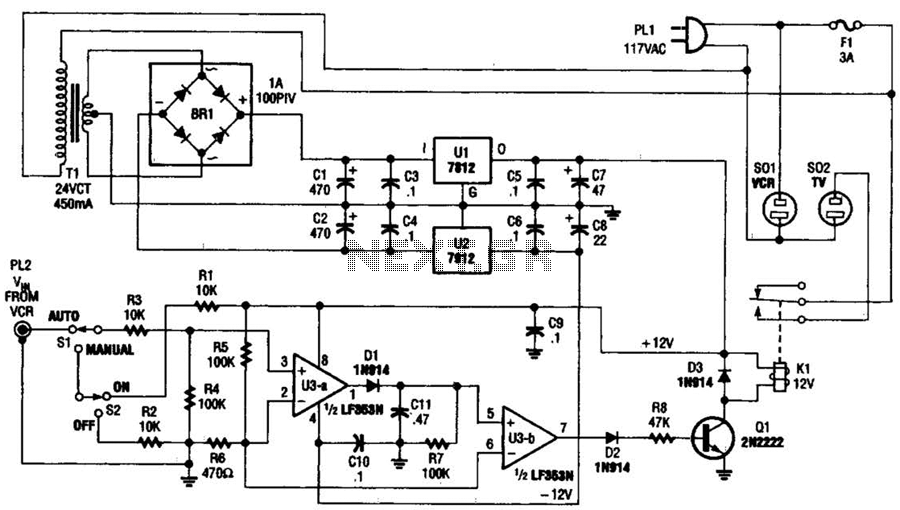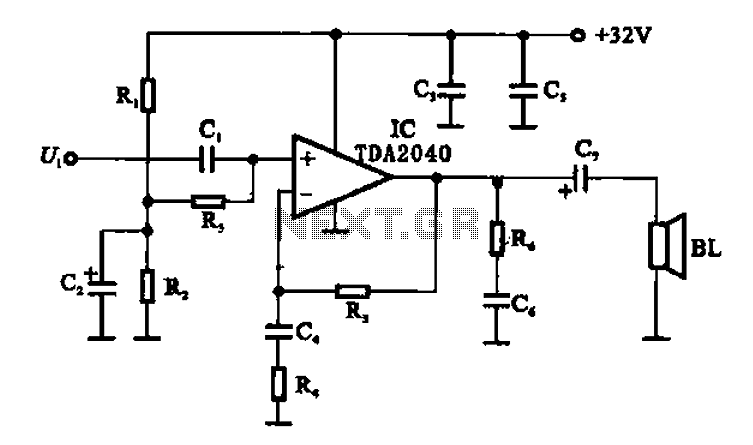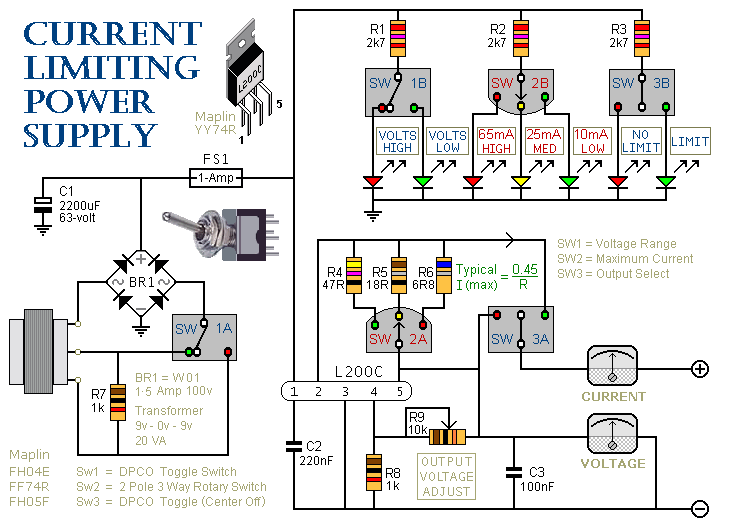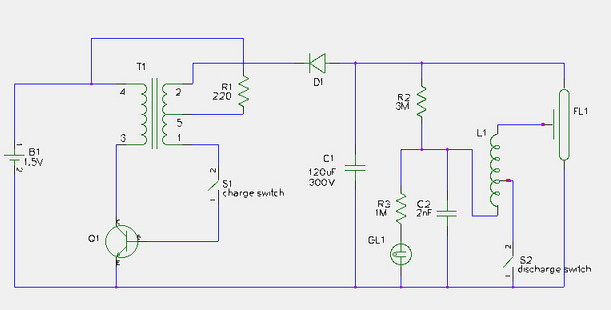
auto power off schematics
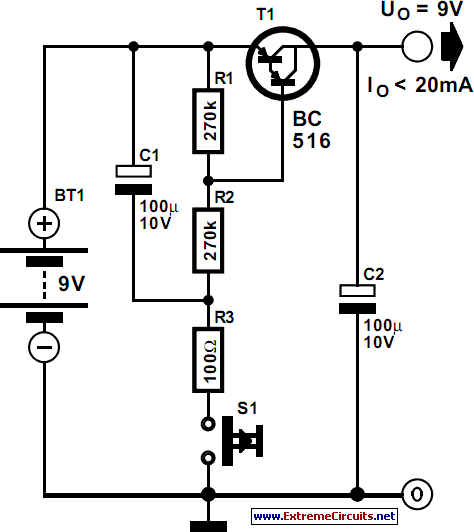
Battery-operated devices are increasingly prevalent, and manufacturers strive to minimize current consumption to enable prolonged operation on battery power. However, even minimal current draw can lead to battery depletion if the device is not powered off, resulting in a flat battery within days or weeks. The circuit described here addresses this issue by automatically disconnecting power from a 9 V battery one minute after activation. The circuit can handle a peak switching current of 20 mA, suitable for most applications. A p-n-p Darlington transistor (T1) serves as the switch, controlled by a push-button switch (S1). The high gain of the Darlington transistor allows it to remain activated for an extended period with a relatively small capacitor (C1 = 100 µF). Resistor R3 limits the charging current to C1, thereby extending the lifespan of S1. Resistors R1 and R2, in conjunction with C1, set the duration of the switch-on time. Once this duration has passed, R1 ensures that T1 is turned off. Because the Darlington transistor can handle a base-emitter voltage (UBE) of 10 V, a polarity protection diode is unnecessary.
The described circuit functions as an automatic power switch for battery-operated devices, enhancing battery life by preventing unnecessary power drain. The core component, the p-n-p Darlington transistor (T1), is selected for its high current gain, which allows for efficient operation even with low input signals. The push-button switch (S1) serves as the user interface for initiating the circuit. When pressed, it activates T1, allowing current to flow from the 9 V battery to the load.
The timing mechanism is established through the combination of capacitor C1 and resistors R1 and R2. The values of these components dictate the timing characteristics of the circuit. Specifically, C1 charges through R3 when S1 is pressed, and the time constant defined by R1 and C1 determines how long T1 remains on. After the preset time elapses, R1 discharges C1, leading to the deactivation of T1 and cutting off power to the device. This design effectively conserves battery life by ensuring that power is only supplied when necessary.
The choice of components is critical to the circuit's performance. Resistor R3 is selected to limit the initial charging current to C1, thereby protecting S1 from excessive wear. The circuit's simplicity and reliance on passive components contribute to its reliability and ease of integration into various battery-operated devices. The absence of a polarity protection diode simplifies the design, as the Darlington transistor's specifications allow it to handle the input voltage without risk of damage.
Overall, this automatic power switch circuit represents an effective solution for extending the operational life of battery-powered devices, ensuring that they remain functional while minimizing the risk of battery depletion due to prolonged inactivity.We are surrounded by battery operated equipment of all kinds, and this array is growing still. Manufacturers and designers lean over backwards to make sure that their equipment draws a small current and can thus be operated by a battery. This has its flip side, too. because even if the equipment in question draws only a small current, when it is n ot switched off, the battery is flat after a few days or weeks. The circuit presented here can prevent this happening. It may be added to all kinds of equipment operating from a 9 V battery and switches this off automatically one minute after a preset time has elapsed. The peak switching current is 20 mA, which is more than enough for most applications. The switch is formed by a p-n-p darlington, T1, which is actuated by push-button switch S1. The very high amplification of the darlington enables it to be kept on fairly long with the aid of a relatively small-value capacitor, C1 (= 100 µF).
Resistor R3 limits the charging current of C1 to ensure a long life of S1. Resistors R1 and R2, in conjunction with C1, determine the switch-on time. When this time has elapsed, R1 ensures that T1 is switched off. Since the darlington can handle a UBE of 10 V, a polarity protection diode is not needed. 🔗 External reference
The described circuit functions as an automatic power switch for battery-operated devices, enhancing battery life by preventing unnecessary power drain. The core component, the p-n-p Darlington transistor (T1), is selected for its high current gain, which allows for efficient operation even with low input signals. The push-button switch (S1) serves as the user interface for initiating the circuit. When pressed, it activates T1, allowing current to flow from the 9 V battery to the load.
The timing mechanism is established through the combination of capacitor C1 and resistors R1 and R2. The values of these components dictate the timing characteristics of the circuit. Specifically, C1 charges through R3 when S1 is pressed, and the time constant defined by R1 and C1 determines how long T1 remains on. After the preset time elapses, R1 discharges C1, leading to the deactivation of T1 and cutting off power to the device. This design effectively conserves battery life by ensuring that power is only supplied when necessary.
The choice of components is critical to the circuit's performance. Resistor R3 is selected to limit the initial charging current to C1, thereby protecting S1 from excessive wear. The circuit's simplicity and reliance on passive components contribute to its reliability and ease of integration into various battery-operated devices. The absence of a polarity protection diode simplifies the design, as the Darlington transistor's specifications allow it to handle the input voltage without risk of damage.
Overall, this automatic power switch circuit represents an effective solution for extending the operational life of battery-powered devices, ensuring that they remain functional while minimizing the risk of battery depletion due to prolonged inactivity.We are surrounded by battery operated equipment of all kinds, and this array is growing still. Manufacturers and designers lean over backwards to make sure that their equipment draws a small current and can thus be operated by a battery. This has its flip side, too. because even if the equipment in question draws only a small current, when it is n ot switched off, the battery is flat after a few days or weeks. The circuit presented here can prevent this happening. It may be added to all kinds of equipment operating from a 9 V battery and switches this off automatically one minute after a preset time has elapsed. The peak switching current is 20 mA, which is more than enough for most applications. The switch is formed by a p-n-p darlington, T1, which is actuated by push-button switch S1. The very high amplification of the darlington enables it to be kept on fairly long with the aid of a relatively small-value capacitor, C1 (= 100 µF).
Resistor R3 limits the charging current of C1 to ensure a long life of S1. Resistors R1 and R2, in conjunction with C1, determine the switch-on time. When this time has elapsed, R1 ensures that T1 is switched off. Since the darlington can handle a UBE of 10 V, a polarity protection diode is not needed. 🔗 External reference
